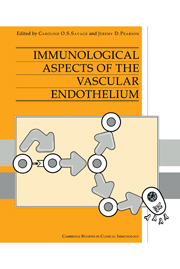Book contents
- Frontmatter
- Contents
- List of contributors
- Preface
- 1 New concepts of mechanisms in autoimmunity
- 2 Regulation of endothelial cell function by cytokines
- 3 Interactions between granulocytes and endothelium
- 4 The regulation of lymphocyte migration by vascular endothelium and its role in the immune response
- 5 Role of the vascular endothelium in immunologically mediated neurological diseases
- 6 The role of the endothelium in systemic lupus erythematosus and Sjögren's syndrome
- 7 The role of the endothelium in rheumatoid arthritis and scleroderma
- 8 The role of the endothelium in systemic vasculitis
- 9 Endothelial involvement in childhood Kawasaki disease
- 10 The role of the endothelium in thrombotic thrombocytopaenic purpura and haemolytic uraemic syndrome
- 11 The immunological role of the endothelium in organ transplantation
- Index
10 - The role of the endothelium in thrombotic thrombocytopaenic purpura and haemolytic uraemic syndrome
Published online by Cambridge University Press: 04 August 2010
- Frontmatter
- Contents
- List of contributors
- Preface
- 1 New concepts of mechanisms in autoimmunity
- 2 Regulation of endothelial cell function by cytokines
- 3 Interactions between granulocytes and endothelium
- 4 The regulation of lymphocyte migration by vascular endothelium and its role in the immune response
- 5 Role of the vascular endothelium in immunologically mediated neurological diseases
- 6 The role of the endothelium in systemic lupus erythematosus and Sjögren's syndrome
- 7 The role of the endothelium in rheumatoid arthritis and scleroderma
- 8 The role of the endothelium in systemic vasculitis
- 9 Endothelial involvement in childhood Kawasaki disease
- 10 The role of the endothelium in thrombotic thrombocytopaenic purpura and haemolytic uraemic syndrome
- 11 The immunological role of the endothelium in organ transplantation
- Index
Summary
Introduction
Thrombotic thrombocytopaenic purpura (TTP) is an uncommon and severe multi-system disease characterized by intravascular platelet aggregation, thrombocytopaenia, central nervous system (and other organ) ischaemia and microangiopathic haemolytic anaemia that mainly occurs in adults (Bukowski, 1982). TTP shows many similarities to haemolytic uraemic syndrome (HUS), a disorder of thrombocytopaenia, microangiopathic haemolytic anaemia and acute renal failure that mainly affects young children (Kaplan & Remuzzi, 1991).
Although many attempts have been made to differentiate TTP and HUS, none of the proposed criteria clearly separates the two syndromes (Remuzzi, 1987a). A clinical distinction based on multi-organ involvement in TTP and renal involvement in HUS is not always apparent (Nalbandian, Henry & Bick, 1979). Even the most widely used criteria, the presence of neurological symptoms in TTP and of renal failure in HUS, fails to distinguish TTP from HUS since neurological involvement has been observed in HUS (Gianantonio, 1964; Sheth, Swick & Haworth, 1986) and many patients classified as having TTP also have renal failure (Amorosi & Ultmann, 1966; Dunea et al., 1966; Eknoyan & Riggs, 1986). The fundamental pathological lesion, thrombotic microangiopathy, is identical in TTP and HUS, and identical aetiological agents and pathogenetic mechanisms have been proposed for both syndromes. Most of the available morphological evidence indicates that endothelial injury is probably the inciting event to the development of microangiopathic lesions.
Factors known to cause TTP and HUS (bacterial endotoxins, antibodies and immune complexes, immunosuppressive agents) can all induce vascular endothelial damage (Remuzzi, 1987b).
- Type
- Chapter
- Information
- Immunological Aspects of the Vascular Endothelium , pp. 213 - 232Publisher: Cambridge University PressPrint publication year: 1995
- 1
- Cited by



